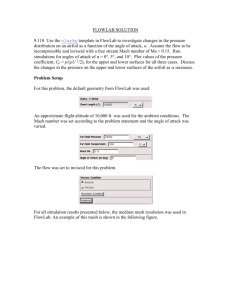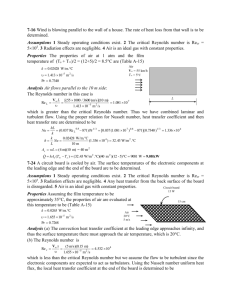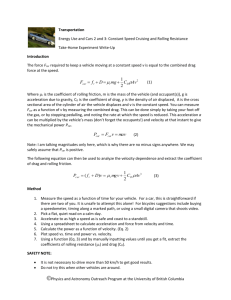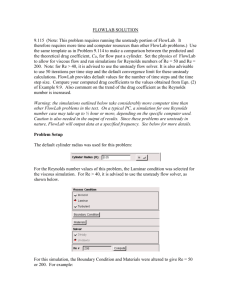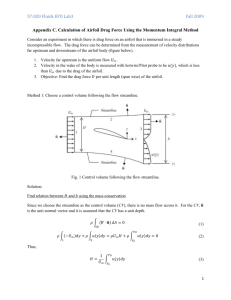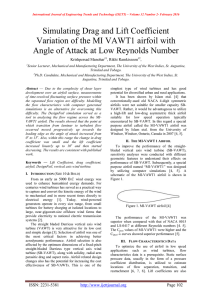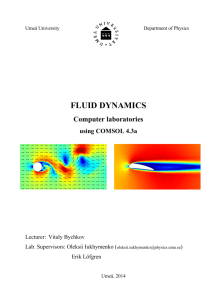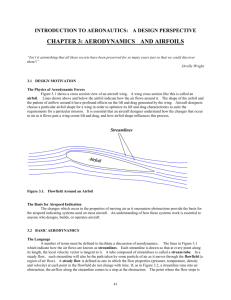HW1 Solution Manual
advertisement
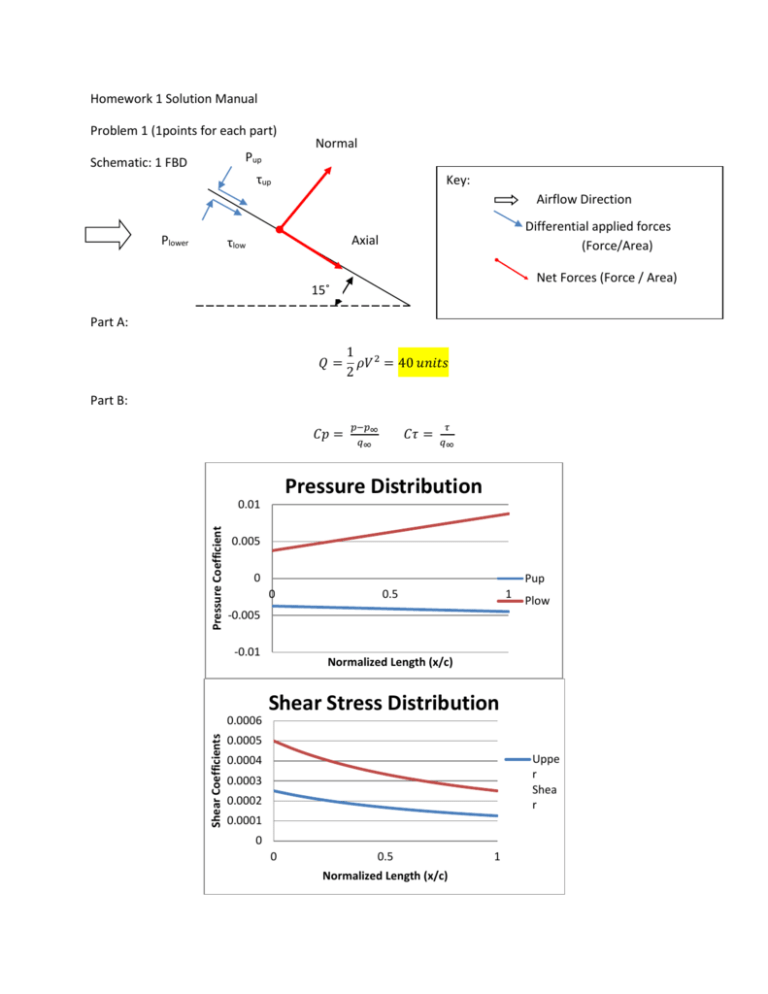
Homework 1 Solution Manual Problem 1 (1points for each part) Pup Schematic: 1 FBD Normal τup Key: Airflow Direction Plower Differential applied forces (Force/Area) Axial τlow er Net Forces (Force / Area) 15˚ Part A: 1 𝑄 = 𝜌𝑉 2 = 40 𝑢𝑛𝑖𝑡𝑠 2 Part B: 𝐶𝑝 = Pressure Coefficient 𝐶𝜏 = 𝜏 𝑞∞ Pressure Distribution 0.01 0.005 0 Pup 0 0.5 1 Plow -0.005 -0.01 0.0006 Shear Coefficients 𝑝−𝑝∞ 𝑞∞ Normalized Length (x/c) Shear Stress Distribution 0.0005 Uppe r Shea r 0.0004 0.0003 0.0002 0.0001 0 0 0.5 Normalized Length (x/c) 1 Part C 𝑁𝑜𝑟𝑚𝑎𝑙 = ∫ 𝑃𝑙𝑜𝑤𝑒𝑟 𝑑𝑥 − ∫ 𝑃𝑢𝑝𝑝𝑒𝑟 𝑑𝑥 Note: Only the pressure is acting perpendicular to the chord length. Refer to the schematic 1 1 1 𝑁𝑜𝑟𝑚𝑎𝑙 = ∫ 0.65 + 0.2𝑥 𝑑𝑥 − ∫ 0.35 − 0.03𝑥 𝑑𝑥 = 0.75 − .335 = .415 𝐹𝑜𝑟𝑐𝑒/𝑊𝑖𝑑𝑡ℎ 0 0 𝐴𝑥𝑖𝑎𝑙 = ∫ 𝜏𝑙𝑜𝑤𝑒𝑟 𝑑𝑥 + ∫ 𝜏𝑢𝑝𝑝𝑒𝑟 𝑑𝑥 Note: Only shear stress is acting parallel to the chord length. Refer to the schematic 1 1 𝐴𝑥𝑖𝑎𝑙 = ∫ 0 1 0.01 0.02 𝑑𝑥 + ∫ 𝑑𝑥 = .0069 + .0139 = .02 𝐹𝑜𝑟𝑐𝑒/𝑊𝑖𝑑𝑡ℎ 1+𝑥 0 1+𝑥 Part D 𝐿𝑖𝑓𝑡 = 𝑁 𝐶𝑜𝑠 𝛼 − 𝐴 𝑆𝑖𝑛 𝛼 = 0.40 𝐹𝑜𝑟𝑐𝑒/𝑊𝑖𝑑𝑡ℎ 𝐷𝑟𝑎𝑔 = 𝑁 𝑆𝑖𝑛 𝛼 + 𝐴 𝐶𝑜𝑠 𝛼 = 0.13 𝐹𝑜𝑟𝑐𝑒/𝑊𝑖𝑑𝑡ℎ Note: Equation 1.1 and 1.2 from the book. Part E 𝐶𝐿 = 𝐶𝐷 = 𝐿𝑖𝑓𝑡 𝐿𝑖𝑓𝑡 / 𝑊𝑖𝑑𝑡ℎ = = .0033 1 2 𝑄𝑐 𝜌𝑉 𝑐 2 𝐷𝑟𝑎𝑔 𝐷𝑟𝑎𝑔 /𝑊𝑖𝑑𝑡ℎ = = .0011 1 2 𝑄𝑐 𝜌𝑉 𝑐 2 Problem 2 Variable Velocity Density Pressure Pressure/Density Density *Velocity ^2 Shear Stress MLT L/T M/L3 M/L*T2 L2/T2 M/L*T2 M/L*T2 MKS m/s kg/m3 kg /m*s2 m2/s2 kg/m*s2 kg/m*s2 Problem 3(Correct Solution 5 pts; Wrong answer, correct approach 3pts; Wrong approach, some work 1 pt ) Physical Variables: Velocity V, Diameter D, Density ρ, Angular Velocity W, Power P Fundamental Dimensions: Mass, Length, Time Physical Variables (N) = 5 Fundamental Dimensions (K) = 3 Pi Terms = ( N-K) = 2 Repeating Variables: Velocity, Diameter, Density Non Repeating Variables: Power, Angular Velocity 1st Pi Term: 𝜋1 = (Power)1 (Velocity)a (Diameter)b (Density)c 1 𝜋1 = (𝑘𝑔 Solve for Kg: Solve for s: Solve for m: m2 m a kg c b ( ) (m) ( ) ) s3 s m3 1 +c = 0 c = -1 -3 –a =0 a = -3 2-3+b+3 =o b =-2 𝜋1 = 𝑃 𝜌𝐷 2 𝑉 3 2nd Pi Term: Solve for Kg: Solve for s: Solve for m: 𝜋2 = (Angular Vel)1 (Velocity)a (Diameter)b (Density)c 1 1 m d kg 𝜋2 = ( ) ( ) (m)e ( 3 )f s s m 0 +f= 0 f = 0 -1–d =0 a = -1 -1+e =o e = 1 𝑊𝐷 𝑉 𝑃 𝑊𝐷 = 𝑓( ) 2 3 𝜌𝐷 𝑉 𝑉 𝜋2 = Problem 4 solutions a) Use the default geometry settings and an angle of attack of 3 degrees, and answer or do the following. Print the plots in the two figures. One point for plots First Plot Second Plot: Is the airfoil symmetric top-to-bottom? Not symmetric (one point) Label which Cp curve is for the upper surface and which is for the lower surface. Upper curve is for the upper surface and the lower curve is for the lower surface. (1 pt) The value of the boundary layer thickness, theta, given by the program is the nondimensional value (theta = /c), where is the dimensional boundary layer thickness and c is the chord length. If the airfoil has a chord length c=3m, what is the dimensional thickness of the viscous region at the end of the airfoil? Upper surface: Θ = theta*c = 3.25*10-3*3 m = 9.75 mm Lower surface: Θ = theta*c = 1.25*10-3*3 m = 3.75 mm (1 pt) The skin friction curve increases rapidly near the leading edge and then decreases. Further back on the airfoil Cf again rapidly increases and then decreases. At the point where Cf rapidly increases the second time, the flow transitions from laminar (smooth) flow to turbulent (chaotic) flow. This nondimensional location is printed as xTransition in figure 2. In terms of x/c where is this transition point located for the upper and lower surfaces? Upper: X/Ctransition = .314 Lower: X/Ctransition = .522 (1pt) (Note the program also gives xSeparation. At this location the thin viscous boundary layer separates from the surface. If the flow is separated over a large portion of the airfoil then the airfoil is stalled.) b) Use the alpha slider to increase the angle of attack to 6 degrees. (Note it is difficult to see the value of alpha in the window and, if too many digits are printed, the leading digit will move out of view. To overcome this you can click in the alpha window and delete some of the digits. When you are done changing alpha hit “Return” to re-compute with this new value.) Describe what happens to the pressure distribution. Note especially the location of minimum pressure and the difference in the pressure on the upper and lower surfaces. The pressure coefficient curves move much further apart and the shape changes. The maximum difference between the curves shifts forward to the front of the airfoil. The location of minimum pressure shifts from .3 to 0 in terms of x/c. (The minimum pressure is where the upper surface pressure coefficient has its minima – which looks like a maxima with the y-axis upside down as it is). What happens to Cl as alpha is increased? Cl increases from .849 to 1.25. In general, Cl increases with increasing angle of attack until the stall angle is reached. When this happens the flow separates from the top surface of the airfoil and the lift coefficient starts to decrease quickly with increasing angle of attack. (total of 1 pt. for both answers) Edit the Reynolds number, Re, by clicking in the box with the value and changing the number. Hit “Return” to re-compute the solution with the new Reynolds number. Use Re = 6e+05, 6e+06 and 6e+07 and answer the following questions. What happens to the transition location on the upper surface as the Reynolds number increases? The transition location moves further forward as the Reynolds number increases What happens to the boundary layer thickness (theta) on the upper surface as the Reynolds number increases? The boundary layer thickness generally decreases. The trends remain the same, however. What happens to the drag coefficient as the Reynolds number increases? The drag coefficient coefficient decreases as the Reynolds number increases What happens to the lift coefficient as the Reynolds number increases (see C l in figure 1)? The Lift coefficient does not change (total 1 pt. for 4 answers) Assume the airfoil has a chord length c=2 m and is flying at sea level under standard atmospheric conditions. According to the standard atmosphere (cite the textbook or website you are using – I am using: http://www.pdas.com/m1.htm): 𝛒∞ = 1.225 kg/m3 μ = 17.89E-6 kg/m-s If the Reynolds number is Re = 6e+06, what is the flight speed U ? Starting with the definition of the Reynolds number and rearranging: 𝝆𝑼∞ 𝒄 𝑹𝒆 = 𝝁 𝑹𝒆 ∙ 𝝁 𝑼∞ = 𝝆∙𝒄 𝒌𝒈 𝟔𝑬𝟔 ∙ 𝟏𝟕. 𝟖𝟗𝑬-6 𝒎 ∗ 𝒔 𝑼∞ = 𝐤𝐠 𝟏. 𝟐𝟐𝟓 𝟐 ∙ 𝟐 m 𝐦 𝑼∞ =43.8 m/s What is the flight speed if the Reynolds number is increased to Re = 6e+07, keeping the chord length and atmospheric conditions fixed? 𝑼∞ =438 m/s (simply multiply by 10) (total 1 pt. for both velocities) What is the dimensional drag (per unit span) for these two cases? 1st case: D’ = cd*.5*ρ*U∞2*c D’ = .00745*.5*1.225*(43.8)2*2 D’ = 17.5 2nd case: D’ = cd*.5*ρ*U∞2*c D’ = .00680*.5*1.225*(438)2*2 D’ = 1598 Does a lower drag coefficient necessarily mean a lower dimensional drag? No! The above calculations show that although the drag COEFFICIENT was higher for the lower Reynolds number, we see that the dimensional drag was in fact lower out of the two cases. From the definition of the drag coefficient, it can be seen that drag is linearly dependent on the drag coefficient, but squarely dependent on the airspeed. Thus, it is actually possible for the drag coefficient to become smaller and still have a significant increase in drag if the velocity increases even slightly. (1 pt. for drags and explanation) Consider the definition of the Reynolds number and answer the following questions: What happens to the Reynolds number if the airfoil is made larger? Re will increase because Re is directly proportional to to the chord length (in the 2-D) case or the wing area (3-D case) If the free-stream velocity is increased? Re will increase because it is directly proportional to the velocity If the altitude is changed from sea level to 12,000 m, while the Mach number and airfoil size are held fixed? From inspection of the standard atmosphere tables one can see that the speed of sound and the absolute viscosity don’t change very much over 12000 ft. This means that the airspeed at 12000 ft. will be similar to the sea level case. However, it is evident that the density decreases very rapidly as altitude increases, and therefore changes in this parameter will have the most significant effect on the Reynolds number. From the definition of Reynolds number, we conclude that the Reynolds number decreases in this case. (1 pt for 4 answers)
